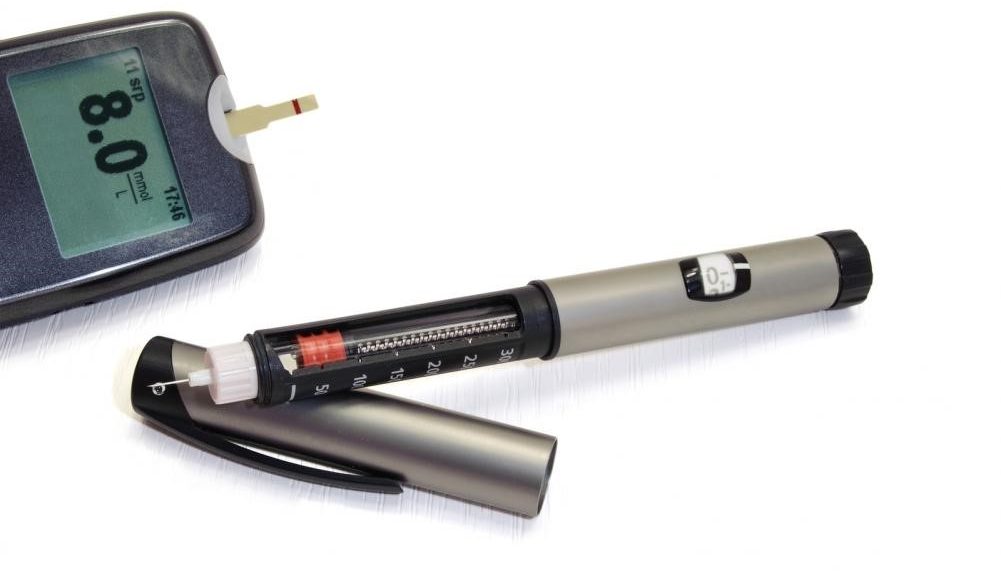Humalog is the brand name for insulin lispro – a fast-acting manufactured insulin that is used to control high blood sugar in people suffering from diabetes mellitus.
For those who do not know, insulin is a naturally occurring hormone that helps maintain the levels of glucose in the blood by initiating its utilization or storage, as per the body’s requirements. When there are higher concentrations of glucose in the blood, insulin signals the liver, fat cells, and muscles to take in glucose. If, at that time, the body is low on energy, the body starts metabolizing the glucose to release energy. But, if the body has sufficient energy, the liver converts glucose into glycogen and stores it for future use.
In people suffering from diabetes, either the pancreas stop producing insulin because of the initiation of autoimmune response within the body (Type 1 diabetes) or the body becomes less sensitive or resistant to insulin and loses its ability to respond to the hormone (Type 2 diabetes).
Humalog – The Man-Made Insulin
Humalog is a manufactured replacement insulin that performs the same function in the body as the natural hormone. However, it acts faster and lasts for a short amount of time as compared to regular insulin. The effects start appearing about 30 minutes after administration and lasts for about 5 hours.
Sold as prescription medicine, Humalog is prescribed to help manage diabetes to both adults and children and works by stimulating the process of glucose absorption by cells, so it can be metabolized and used for energy.
Available Dosage Forms and Strengths of Humalog
Humalog is available in 100 units/ml (U-100) and 200 units/ml (U-200) strengths and in the following varieties:
Humalog 100 units/ml:
- 100 ml vials
- 3 ml vials
- 3 ml cartridges
- 3 ml Humalog KiwiPen (prefilled)
- 3 ml Humalog Junior KiwiPen (prefilled)
Humalog 200 units/ml:
- 3 ml Humalog KiwiPen (prefilled)
Dosage
The right dosage of Humalog for a person depends on a variety of factors and hence, varies across patients. Some of the factors that play a key role in determining the right dosage are:
- The metabolic needs of the individual
- Route of administration
- Blood glucose monitoring results
- Glycemic control goal
The patient needs to be regularly monitored while taking insulin lispro and the dosage may need to be adjusted if there are changes in:
- Meal patterns. This includes both the timings of food consumption as well as the nutrient content of the food.
- Physical activity
- Hepatic or renal function
- Changes in overall health
Humalog dosage may also need to be adjusted if:
- The patient is suffering from an acute illness.
- It is administered along with certain other drugs.
What Should You Do In Case Of an Overdose?
Taking an excessive amount of insulin can cause hypoglycemia i.e. low blood sugar. In some cases, it may also cause hypokalemia i.e. low blood potassium.
While mild cases of hypoglycemia can be easily treated by oral administration of glucose, a drastic drop in the blood glucose level needs to be treated by intravenous administration of concentrated glucose or intramuscular glucagon.
In rare cases, severe episodes of hypoglycemia may cause neurologic impairment, coma, or seizures.
In case you mistakenly take an overdose of Humalog, continue to monitor your blood sugar levels and immediately drink fruit juice or any other sugary drink if there is a drop in glucose level. Continue to monitor and consume carbohydrate for some time, even after you have apparently recovered because hypoglycemia may recur after some time as the medicine continues to function inside your body.
Seek medical help if the glucose level doesn’t become normal by oral consumption of sugary drinks.
Administration of Humalog
The manufactured insulin can be administered by injection or by an insulin pump.
Taking Humalog via Injection
While there are two ways to administer Humalog via injection i.e. subcutaneous injection and intravenous injection, the latter method is only used by doctors, as and when needed. When a patient is prescribed to take Humalog via injection, it is always through the first method.
Subcutaneous Injection
Humalog needs to be administered about 15 minutes before a meal or immediately after it into the subcutaneous tissues of upper arms, thighs, abdominal wall, or buttocks.
When administered this way, the fast-acting insulin is generally taken along with intermediate or long-acting insulin.
Both dosage strengths of Humalog i.e. U-100 and U-200 can be taken via subcutaneous injections.
Note: It is recommended to change the injection site, within the same area, every time you administer Humalog. This is to reduce the risk of lipodystrophy – a disorder of adipose tissues that causes selective loss of body fat.
Taking Humalog via Insulin Pump
Using insulin pump is also a method for subcutaneous infusion of Humalog, but it provides a continuous supply of insulin in small doses as opposed to the quick infusion in slightly higher dosage via injection.
If you are prescribed to administer insulin lisprovia an insulin pump, remember that you should only use Humalog U-100 – Humalog U-200 should not be used via an infusion pump.
Consult your doctor to determine the right infusion rate, both at meal times and otherwise and stick to the recommendations to avoid the chances of overdose.
Note
Make sure to follow the following instructions when you are using Humalog through an insulin pump:
- Change the infusion set and the insertion site after every 3 days.
- Change the insulin in the pump reservoir at least after every 7 days.
- Do not dilute or mix Humalog with any other type of insulin
- Make sure to not expose the insulin in the pump reservoir to temperatures higher than 98.6 degrees Fahrenheit (37 degrees Centigrade).
Important Instructions
Here are some of the things that you should know and follow while using the manufactured insulin:
- Never share your Humalog pen, cartridge, or syringe with anyone, even after changing the needle.
- Store unopened Humalog in the refrigerator – do not freeze.
- Do not use the insulin if it has been frozen
- Humalog doesn’t need to be stored in the refrigerator while in use. However, make sure to store it at temperatures below 86 degrees Fahrenheit (30 degrees Centigrade) and use within 28 days of opening.
- Discard the opened Humalog after 28 days, even if you have not used it completely.
- Protect the manufactured insulin from direct light and heat.
How Long Does Humalog remain in the Patient’s Body?
As mentioned earlier, the effects of Humalog starts appearing after half an hour and last for about 5 hours.
Possible Side Effects of Humalog
While manufactured insulins are generally safe to use, they may cause some side effects in some cases. This section highlights the effects that you may experience with Humalog.
Common Side Effects
The most common effects that people experience, often due to overdose, are:
- Hypoglycemia; low blood sugar
- Hypokalemia; low blood potassium
However, patients may also experience itching, swelling, and/or redness at the site of injection. While these local allergy reactions usually disappear with a few days (they may take a few weeks in some patients), the patient may need to discontinue the use of Humalog in some cases.
Negative Effects of Humalog Observed In Clinical Trial
Humalog has shown a range of side effects during clinical trials. While the frequency of their occurrence was low, one should be always vigilant and consult a doctor if any of the effects last for a long time.
Adverse Effects of Humalog in Patients with Type 1 Diabetes
- Bronchitis
- Nausea
- Cough
- Fever
- Headache
- Abdominal pain
- Diarrhea
- Flu syndrome
- Rhinitis
- Pharyngitis
- Different types of infections, such as urinary tract infection
- Myalgia
- Dysmenorrhea
- Asthenia
Adverse Effects of Humalog in Patients with Type 2 Diabetes
- Flu syndrome
- Rhinitis
- Pharyngitis
Long-Term Effects of Humalog
The long-term usage of Humalog may cause:
- Lipodystrophy, particularly in case of repeated infusions or injections at the same site
- Sodium retention and peripheral edema, particularly in cases where intense insulin therapy is undertaken to improve poor metabolic control
- Weight gain
- Long-term administration of insulin may cause severe, generalized allergies in some patients that could be life-threatening. Generalized insulin allergy may cause body rash, wheezing, anaphylaxis, tachycardia, wheezing, dyspnea, hypotension, or diaphoresis.
Possible Drug Interactions of Humalog
Just like most other medications, Humalog can interact with some drugs and cause negative effects.
The use of Humalog with the following drugs may put the patients at an increased risk of hypoglycemia:
- Antidiabetic agents
- ACE inhibitors
- Monoamine oxidase inhibitors
- Salicylates
- Sulfonamide antibiotics
- Fluoxetine
- Pramlintide
- Disopyramide
- Fibrates
- Pentoxifylline
- Propoxyphene
- Angiotensin II receptor blocking agents
- Somatostatin analogs, for example, octreotide.
Following drugs can reduce the effectiveness of Humalog in lowering blood glucose levels:
- Corticosteroids
- Isoniazid
- Niacin
- Estrogens
- Oral contraceptives
- Phenothiazines
- Danazol
- Diuretics
- Sympathomimetic agents, such as epinephrine, albuterol, and terbutaline
- Somatropin
- Atypical antipsychotics
- Glucagon
- Protease inhibitors
- Thyroid hormones
Lithium salts, clonidine, beta-blockers, and alcohol can also increase or decrease the effectiveness of Humalog in reducing blood glucose levels.
Tell Your Doctor If You Are…
- Pregnant or planning to get pregnant
- Suffering from renal or hepatic impairments
- Nursing mother. While it is not known that whether insulin lispro passes into breast milk or not, caution should be exercised while administering Humalog to nursing mothers.
Who Should Not Take Humalog?
Although Humalog is considered safe for use in both adults and children, its effects have not been studied in children under 3 years of age. So, it should not be used for toddlers unless prescribed by a registered physician or diabetic consultant.
Prescription Assistance for Humalog
The Lilly Cares Foundation Inc. is a non-profit organization that offers patient assistance program to help qualifying patients get prescribed medicines at no cost. The foundation has recently launched a new program to make diabetes medicines more accessible to patients who are not insured or underinsured and cannot afford to buy them either.
If you have not already been registered with a prescription assistance program, call 1-8-333-808-1234 to get in touch with the Lilly Diabetes Solution Center or visit the RX Assist website to check your eligibility for Lilly Care programs
You can also check out the list of programs that offer prescription assistance to diabetic patients at the American Diabetes Association’s website.


